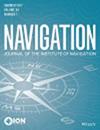基于小卫星的月球卫星导航系统的GPS时间传递设计
IF 2
3区 地球科学
Q1 ENGINEERING, AEROSPACE
引用次数: 2
摘要
随着太空探索新领域的出现,月球旅行是未来深空任务成功的关键垫脚石。许多国际空间机构,如美国国家航空航天局(NASA)、欧洲航天局(ESA)、中国国家航天局(CNSA)、日本宇宙航空研究开发机构(JAXA)和俄罗斯国家空间活动公司(Roscosmos),都对在月球上建立可持续的人类存在表现出越来越大的兴趣(Laurini & Gerstenmaier, 2014)。10个国际空间机构计划在未来十年内执行40多项月球任务(Tai et al., 2020)。在阿波罗计划结束50多年后,美国宇航局的阿尔忒弥斯任务将在本世纪20年代中期将人类送上月球,包括第一位女性和第一位有色人种(Smith et al., 2020)。此外,SpaceX和Blue Origin等私营公司也在积极投资登月计划。用户定位、导航和定时(PNT)是各种月球应用的基础,包括任务活动规划、搜索和救援行动,以及校准的科学有效载荷数据样本的地理标记(Israel et al., 2020)。对于未来的月球导航卫星系统(LNSS),一个类似gps的月球星座,美国宇航局表示有兴趣使用小型卫星平台。然而,许多设计决策尚未最终确定,包括轨道、星座和机载时钟。此外,设计一个专用的基于小卫星的LNSS限制了有效载荷能力,从而限制了机载时钟的尺寸、重量和功率(SWaP)。我们提出了一种具有间歇可用GPS信号时间传输的LNSS设计,其中我们设计了一个卡尔曼滤波器来估计低swap时钟的时间校正。此外,我们设计了一个月球用户等效距离误差(UERE)度量来表征LNSS卫星传输的信号的测距精度。我们进一步验证了我们的时间传递技术,模拟了LNSS卫星在椭圆形月球冻结轨道(ELFO)上的时间传递技术,同时分析了GPS、定时误差和月球UERE在ELFO上的能见度影响。本文章由计算机程序翻译,如有差异,请以英文原文为准。
Time Transfer From GPS for Designing a SmallSat-Based Lunar Navigation Satellite System
With the advent of new frontiers in space exploration, traveling to the Moon serves as a crucial stepping stone for the success of future deep space missions. Many international space agencies, such as the National Aeronautics and Space Administration (NASA), European Space Agency (ESA), China National Space Administration (CNSA), Japan Aerospace Exploration Agency (JAXA), and Roscosmos State Corporation for Space Activities (Roscosmos), have demonstrated a growing interest in building a sustainable human presence on the Moon (Laurini & Gerstenmaier, 2014). More than 40 lunar missions are being planned within the next decade by 10 international space agencies (Tai et al., 2020). After more than 50 years since the Apollo program ended, NASA’s Artemis mission will land humans on the Moon in the mid-2020s, including the first woman and first person of color (Smith et al., 2020). Furthermore, active efforts on traveling to the Moon are also being invested in by private sector companies like SpaceX and Blue Origin. User position, navigation, and timing (PNT) serves as the basis for various lunar applications that include mission activity planning, search-and-rescue operations, and geotagging calibrated scientific payload data samples (Israel et al., 2020). Stanford University Abstract For the future lunar navigation satellite system (LNSS), a GPS-like constellation for the Moon, NASA has expressed interest in using a smallsat platform. However, many design decisions have yet to be finalized, including the orbit, constellation, and onboard clock. Furthermore, designing a dedicated smallsat-based LNSS limits the payload capacity, thus restricting the size, weight, and power (SWaP) of the onboard clock. We propose an LNSS design with time transfer from intermittently available GPS signals wherein we design a Kalman filter to estimate timing corrections for a low-SWaP clock. Additionally, we devise a lunar User Equivalent Range Error (UERE) metric to characterize the ranging accuracy of signals transmitted by an LNSS satellite. We further validate our time-transfer technique with simulations of an LNSS satellite in an elliptical lunar frozen orbit (ELFO) with an onboard chip scale atomic clock (CSAC) while analyzing the visibility effects of GPS, timing errors, and lunar UERE across ELFOs.
求助全文
通过发布文献求助,成功后即可免费获取论文全文。
去求助
来源期刊

Navigation-Journal of the Institute of Navigation
ENGINEERING, AEROSPACE-REMOTE SENSING
CiteScore
5.60
自引率
13.60%
发文量
31
期刊介绍:
NAVIGATION is a quarterly journal published by The Institute of Navigation. The journal publishes original, peer-reviewed articles on all areas related to the science, engineering and art of Positioning, Navigation and Timing (PNT) covering land (including indoor use), sea, air and space applications. PNT technologies of interest encompass navigation satellite systems (both global and regional), inertial navigation, electro-optical systems including LiDAR and imaging sensors, and radio-frequency ranging and timing systems, including those using signals of opportunity from communication systems and other non-traditional PNT sources. Articles about PNT algorithms and methods, such as for error characterization and mitigation, integrity analysis, PNT signal processing and multi-sensor integration, are welcome. The journal also accepts articles on non-traditional applications of PNT systems, including remote sensing of the Earth’s surface or atmosphere, as well as selected historical and survey articles.
 求助内容:
求助内容: 应助结果提醒方式:
应助结果提醒方式:


